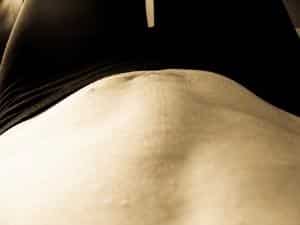Physiotherapy tips for toning your postpartum belly

As transversus abdominis control and activation improves, more challenging abdominal exercises can be included, such as modified planks, push-ups, crunches and oblique exercises. Again these need to be started at an appropriate level, and progressed as core control improves. The aim of the early phase of rehabilitation is to regain good technique and coordinated activation of the abdominals, lower back muscles and pelvic stabilisers.
Special considerations for toning your postpartum belly and abdomen
-
Diastasis of the Rectus Abdominis Muscle (DRAM)
In the presence of an ongoing DRAM) core exercises will need to be modified to ensure that the DRAM improves rather than worsens. The key things to monitor are the size of the ‘gap’ during abdominal exercises (to make sure it’s not widening), and avoid any abdominal bulging, doming, tenting or herniation through the DRAM.
If you do have a significant DRAM, such as the example pictured, then you should consult a women’s health physiotherapist in Brisbane. They will assess your DRAM and the impact of different core exercises on the DRAM. Due to significant individual variation, there is not one correct or ‘safe’ exercise for DRAM. Some people’s diastasis improves most with activation of transversus, whilst others do best with crunches or modified oblique exercises. Your Women’s Health Physio will assess you doing a variety of exercises and prescribe the one that is most effective for you.

-
Pelvic Organ Prolapse/Weak Pelvic Floor
If you have pelvic organ prolapse, then it will be important to ensure that your prolapse is not negatively affected by the abdominal exercises you do. Crunches are often implicated as an exercise to be avoided by women with weak pelvic floors or pelvic organ prolapse. Research suggests that when done properly, the pressure on the pelvic organs and pelvic floor is less during crunching than when simply standing still. As such, doing crunches with correct technique may be safe even if you have a weak pelvic floor or pelvic organ prolapse. Similarly, plank and push-up style exercises can increase the pressure on the pelvic organs and pelvic floor, but if done well with good technique (including correct pelvic floor engagement), may be safe. It is important to get your women’s health physio to check your technique and pelvic organ position during these exercises to ensure they are safe for you.
Exercises such as basic transversus activation and bridging are typically safe for women with weak pelvic floors or pelvic organ prolapse as they do not exert significant pressure on the pelvic organs or pelvic floor.
-
Post Caesarean Section
If you have had a caesarean section, it is important to minimise lifting, carrying and abdominal load during the first six weeks. This is essential to allow the abdominal and uterine incisions to heal well. After the first six weeks (if the wounds are healing well), gentle core rehabilitation should be started gradually, and may include gentle, progressive activation of the transversus abdominis, bridging style exercises and light resistance exercises in functional positions. These exercises can be gradually progressed until you are 12 weeks post-caesar, at which point more challenging core exercises can be added (as per the general principles section above) provided you have developed good base level control and activation.
Overall, it is important to rebuild your abdominals and core control after pregnancy and birth to regain function and reduce the risk of other injuries. If you are unsure of how to proceed, or feel any symptoms whilst doing core exercises (pain, incontinence, or vaginal pressure, heaviness or bulging) then you should consult a Women’s Health Physiotherapy in Brisbane for an assessment and provision of a tailored exercise program.
Contact Graceville Physio to start postpartum abdominal rehab today.
Our pregnancy focussed physio treatments will ensure you’re able to get on top of these issues before they have an ongoing impact on your life. Book an appointment with us today – and happy exercising Mum’s!


